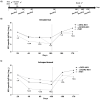Intradermal Delivery of Dendritic Cell-Targeting Chimeric mAbs Genetically Fused to Type 2 Dengue Virus Nonstructural Protein 1
- PMID: 33019498
- PMCID: PMC7712967
- DOI: 10.3390/vaccines8040565
Intradermal Delivery of Dendritic Cell-Targeting Chimeric mAbs Genetically Fused to Type 2 Dengue Virus Nonstructural Protein 1
Abstract
Targeting dendritic cells (DCs) by means of monoclonal antibodies (mAbs) capable of binding their surface receptors (DEC205 and DCIR2) has previously been shown to enhance the immunogenicity of genetically fused antigens. This approach has been repeatedly demonstrated to enhance the induced immune responses to passenger antigens and thus represents a promising therapeutic and/or prophylactic strategy against different infectious diseases. Additionally, under experimental conditions, chimeric αDEC205 or αDCIR2 mAbs are usually administered via an intraperitoneal (i.p.) route, which is not reproducible in clinical settings. In this study, we characterized the delivery of chimeric αDEC205 or αDCIR2 mAbs via an intradermal (i.d.) route, compared the elicited humoral immune responses, and evaluated the safety of this potential immunization strategy under preclinical conditions. As a model antigen, we used type 2 dengue virus (DENV2) nonstructural protein 1 (NS1). The results show that the administration of chimeric DC-targeting mAbs via the i.d. route induced humoral immune responses to the passenger antigen equivalent or superior to those elicited by i.p. immunization with no toxic effects to the animals. Collectively, these results clearly indicate that i.d. administration of DC-targeting chimeric mAbs presents promising approaches for the development of subunit vaccines, particularly against DENV and other flaviviruses.
Keywords: DCIR2; DEC205; Dengue virus; NS1 protein; dendritic cell; intradermal.
Conflict of interest statement
The authors declare no conflict of interest.
Figures




Similar articles
-
Targeting the non-structural protein 1 from dengue virus to a dendritic cell population confers protective immunity to lethal virus challenge.PLoS Negl Trop Dis. 2013 Jul 18;7(7):e2330. doi: 10.1371/journal.pntd.0002330. Print 2013. PLoS Negl Trop Dis. 2013. PMID: 23875054 Free PMC article.
-
Dendritic Cell Targeting Using a DNA Vaccine Induces Specific Antibodies and CD4+ T Cells to the Dengue Virus Envelope Protein Domain III.Front Immunol. 2019 Jan 29;10:59. doi: 10.3389/fimmu.2019.00059. eCollection 2019. Front Immunol. 2019. PMID: 30761131 Free PMC article.
-
CpG Oligodeoxinucleotides and Flagellin Modulate the Immune Response to Antigens Targeted to CD8α+ and CD8α- Conventional Dendritic Cell Subsets.Front Immunol. 2017 Dec 4;8:1727. doi: 10.3389/fimmu.2017.01727. eCollection 2017. Front Immunol. 2017. PMID: 29255470 Free PMC article.
-
Development of a recombinant, chimeric tetravalent dengue vaccine candidate.Vaccine. 2015 Dec 10;33(50):7112-20. doi: 10.1016/j.vaccine.2015.11.022. Epub 2015 Nov 14. Vaccine. 2015. PMID: 26585500 Review.
-
Early dengue virus interactions: the role of dendritic cells during infection.Virus Res. 2016 Sep 2;223:88-98. doi: 10.1016/j.virusres.2016.07.001. Epub 2016 Jul 2. Virus Res. 2016. PMID: 27381061 Review.
Cited by
-
Targeted delivery of autoantigen to dendritic cells prevents development of spontaneous uveitis.Front Immunol. 2023 Sep 1;14:1227633. doi: 10.3389/fimmu.2023.1227633. eCollection 2023. Front Immunol. 2023. PMID: 37727784 Free PMC article.
-
Pharmacological Evaluation of active compounds in papaya associated with thrombocytopenia inhibition in dengue patients through in silico approaches.Sci Rep. 2025 Jul 24;15(1):26922. doi: 10.1038/s41598-025-09835-w. Sci Rep. 2025. PMID: 40707585 Free PMC article.
References
-
- Mahnke K., Guo M., Lee S., Sepulveda H., Swain S.L., Nussenzweig M., Steinman R.M. The Dendritic Cell Receptor for Endocytosis, Dec-205, Can Recycle and Enhance Antigen Presentation via Major Histocompatibility Complex Class II–Positive Lysosomal Compartments. J. Cell Biol. 2000;151:673–684. doi: 10.1083/jcb.151.3.673. - DOI - PMC - PubMed
Grants and funding
- 2014/17595-0/Fundação de Amparo à Pesquisa do Estado de São Paulo
- 2013/26942-2/Fundação de Amparo à Pesquisa do Estado de São Paulo
- 2016/05570-8/Fundação de Amparo à Pesquisa do Estado de São Paulo
- 2014/17595-0/Fundação de Amparo à Pesquisa do Estado de São Paulo
- 14/04303-0/Fundação de Amparo à Pesquisa do Estado de São Paulo
LinkOut - more resources
Full Text Sources
Research Materials

